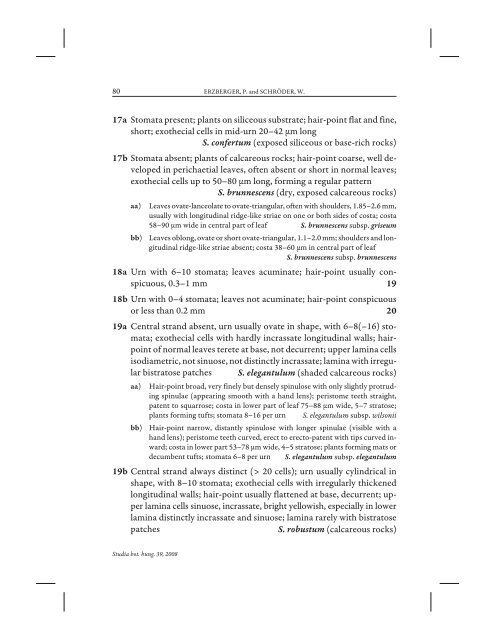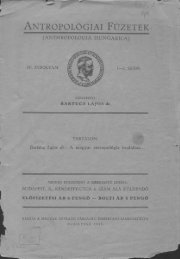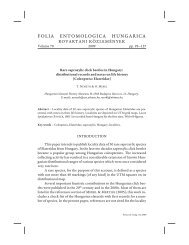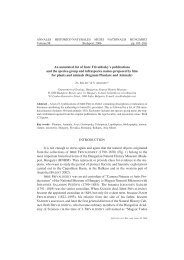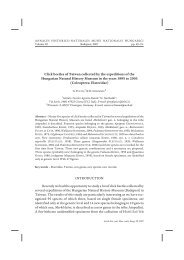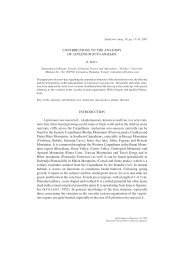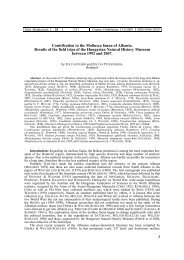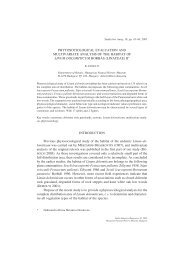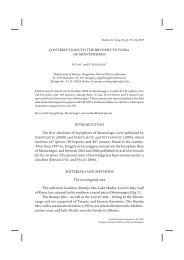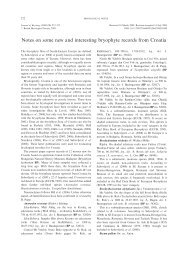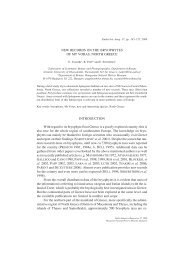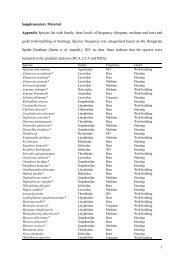THE GENUS SCHISTIDIUM (GRIMMIACEAE, MUSCI) IN HUNGARY ...
THE GENUS SCHISTIDIUM (GRIMMIACEAE, MUSCI) IN HUNGARY ...
THE GENUS SCHISTIDIUM (GRIMMIACEAE, MUSCI) IN HUNGARY ...
You also want an ePaper? Increase the reach of your titles
YUMPU automatically turns print PDFs into web optimized ePapers that Google loves.
80 ERZBERGER, P. and SCHRÖDER, W.<br />
Stomata present; plants on siliceous substrate; hair-point flat and fine,<br />
short; exothecial cells in mid-urn 20–42 μm long<br />
(exposed siliceous or base-rich rocks)<br />
Stomata absent; plants of calcareous rocks; hair-point coarse, well developed<br />
in perichaetial leaves, often absent or short in normal leaves;<br />
exothecial cells up to 50–80 μm long, forming a regular pattern<br />
(dry, exposed calcareous rocks)<br />
) Leaves ovate-lanceolate to ovate-triangular, often with shoulders, 1.85–2.6 mm,<br />
usually with longitudinal ridge-like striae on one or both sides of costa; costa<br />
58–90 μm wide in central part of leaf subsp.<br />
) Leaves oblong, ovate or short ovate-triangular, 1.1–2.0 mm; shoulders and longitudinal<br />
ridge-like striae absent; costa 38–60 μm in central part of leaf<br />
subsp.<br />
Urn with 6–10 stomata; leaves acuminate; hair-point usually conspicuous,<br />
0.3–1 mm<br />
Urn with 0–4 stomata; leaves not acuminate; hair-point conspicuous<br />
or less than 0.2 mm<br />
Central strand absent, urn usually ovate in shape, with 6–8(–16) stomata;<br />
exothecial cells with hardly incrassate longitudinal walls; hairpoint<br />
of normal leaves terete at base, not decurrent; upper lamina cells<br />
isodiametric, not sinuose, not distinctly incrassate; lamina with irregular<br />
bistratose patches<br />
(shaded calcareous rocks)<br />
) Hair-point broad, very finely but densely spinulose with only slightly protruding<br />
spinulae (appearing smooth with a hand lens); peristome teeth straight,<br />
patent to squarrose; costa in lower part of leaf 75–88 μm wide, 5–7 stratose;<br />
plants forming tufts; stomata 8–16 per urn S. elegantulum subsp. wilsonii<br />
) Hair-point narrow, distantly spinulose with longer spinulae (visible with a<br />
hand lens); peristome teeth curved, erect to erecto-patent with tips curved inward;<br />
costa in lower part 53–78 μm wide, 4–5 stratose; plants forming mats or<br />
decumbent tufts; stomata 6–8 per urn<br />
subsp.<br />
Central strand always distinct (> 20 cells); urn usually cylindrical in<br />
shape, with 8–10 stomata; exothecial cells with irregularly thickened<br />
longitudinal walls; hair-point usually flattened at base, decurrent; upper<br />
lamina cells sinuose, incrassate, bright yellowish, especially in lower<br />
lamina distinctly incrassate and sinuose; lamina rarely with bistratose<br />
patches<br />
(calcareous rocks)<br />
Studia bot. hung. 39, 2008


